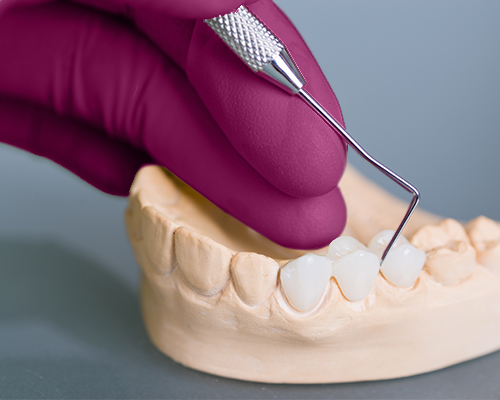
ODDZIAŁY
Description of the service
A dental bridge enables to replace one to even several teeth. It is permanently placed in the oral cavity, ensuring high comfort of use. A dental bridge can be made as part of prosthetic treatment carried out at our enel-med medical centres.
A dental bridge is a durable, comfortable and aesthetic method of restoring missing natural teeth. With it, it is possible to replace one or even several missing teeth, using the patient’s own teeth or implants. A dental bridge consists of abutments and a connector that are permanently connected to each other. The bridge is placed on properly prepared patient’s own teeth or implants. An abutment tooth can be either a living tooth or a devitalised one (after endodontic treatment). In this case, a crown-root inlay is introduced into the root canal. Between the abutments, there is a connector that restores the patient’s missing teeth in the oral cavity.
Dental bridge – indications
Dental bridges are primarily fitted in patients who have one or more teeth missing, provided that these are interdental losses (i.e. surrounded by the patient’s own teeth or implants). Abutment teeth should be treated and have no signs of caries, and in the case of teeth after root-canal treatment, their canals should be properly prepared and filled, and there should be no inflammatory lesions near the root apex.
An alternative is to place implants in the patient’s oral cavity (one missing tooth – one implant) – only afterwards is the dental restoration planned. The second solution are removable dentures in the form of partial dentures.
Dental bridge – types
There are several types of dental bridges:
- Adhesive bridge: replaces a single missing tooth. Depending on the situation, it may be a permanent or temporary restoration (e.g. during implant treatment, when the patient waits for the implant to grow in). This type of bridge is a good solution for replacing missing teeth in children and adolescents before the end of maxillary and mandibular development, allowing to postpone the implant-prosthetic treatment or the introduction of restorations in the form of a standard dental bridge. The bridge is attached to healthy adjacent teeth without interfering with their tissues, by means of fibreglass wings to which the artificial crown is attached. Only minimal preparation of the patient’s own teeth is necessary. The spaces left by fillings already present in the tooth are often used. The wings of the adhesive bridge with the connector (the artificial crown) are set in these places.
- A standard porcelain dental bridge is durable and gives very good aesthetic results. The structure can be made of metal (a durable and relatively inexpensive solution), gold (additional bacteriostatic effect; recommended for people allergic to metals) or zirconium oxide (currently provides the best cosmetic effect; very durable and does not cause allergies).
- A metal bridge is affordable and durable, but unfortunately the aesthetic results are not satisfactory
- A temporary acrylic bridge is a restoration placed temporarily when the patient waits for the final work. It enables the patient to function normally, has reasonable aesthetic results, but is not very durable.
Dental bridge – what is the treatment like?
Prosthetic treatment with the use of dental bridges carried out at enel-med medical centres consists of several strictly defined stages.
- It starts with a prosthetic consultation. The doctor examines the patient’s oral cavity, evaluates the condition of the teeth, roots and the bone surrounding the teeth (this may require an X-ray, e.g. orthopantomogram, periapical X-ray or CBCT). Before proceeding with the prosthetic treatment, cariogenic lesions and inflammations of periodontal tissues must be treated; sometimes periodontal, implant or orthodontic treatment may be recommended.
- Once the initial treatment is completed, the proper prosthetic treatment begins. The doctor prepares the abutment teeth on which the dental bridge will be set. Next, impressions of the upper and lower arch are taken. Based on these, the lab technician recreates the occlusal conditions in the patient’s oral cavity on a plaster model, and proceeds with individual stages of preparation of the planned bridge.
- For the period when the work at the lab continues, the dentist secures the polished abutment teeth with a temporary acrylic bridge. The bridge enables the patient to function normally.
- Before placing the dental bridge, the dentist checks whether the lab has done the job correctly and performs a fitting. At this stage, the patient can make reservations about the shape and colour of the bridge, and the doctor can send the work back to the laboratory for adjustments.
- After the patient accepts the adjustments, the dental bridge is fixed permanently. After this stage, not all corrections are possible
In order to use the dental bridge for a long time, take care of your oral hygiene, undergo regular and professional teeth cleaning procedures, and appear for check-up visits scheduled by your dentist during the warranty period.
Contact form
Please complete the form below. We will call you back, tell you about the details of the offer and arrange an appointment for you.



